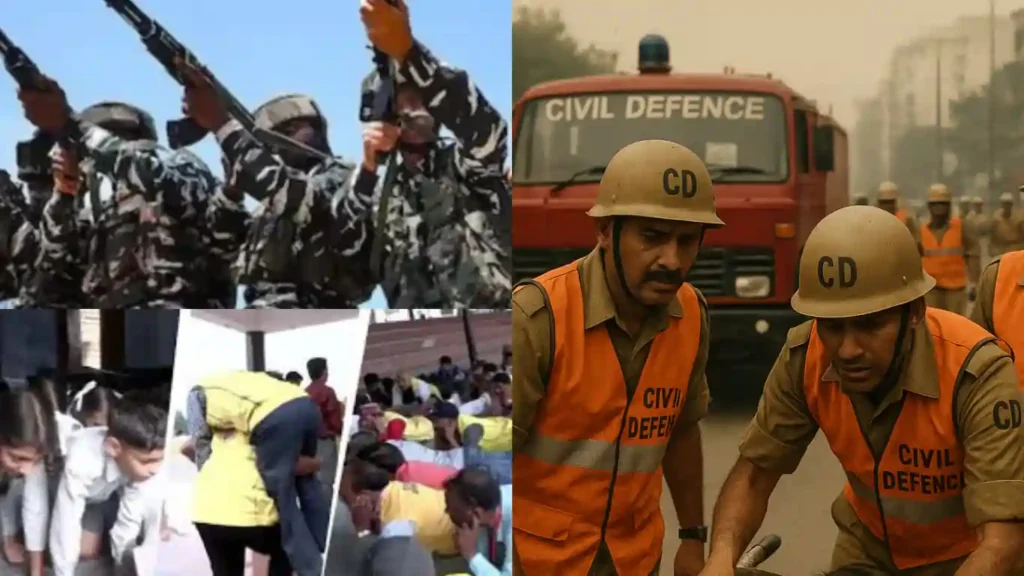New Delhi: In a significant move to bolster national security, the Ministry of Home Affairs (MHA) has directed all states and Union Territories to conduct mock drills across 244 categorised Civil Defence Districts on May 7, 2025. This nationwide Civil Defence Exercise, the first of its scale since the 1971 India-Pakistan War, aims to evaluate and enhance India’s preparedness for emergencies such as war, missile attacks, aerial strikes, or natural disasters. The directive comes in the wake of escalating tensions with Pakistan, particularly following the April 22, 2025, Pahalgam terror attack in Jammu and Kashmir, which claimed 26 civilian lives.

Why Is India Conducting Civil Defence Drills?
The MHA’s order, issued on May 2 and updated on May 6, cites “new and complex threats” emerging in the “current geo-political scenario.” The Pahalgam terror attack, coupled with Pakistan’s recent missile tests under “Exercise INDUS,” has heightened concerns about potential hostilities. Pakistan conducted its second missile firing test in two days, with Prime Minister Shehbaz Sharif asserting that the successful launch demonstrated the strength of Pakistan’s defence capabilities. Additionally, the Pakistan Army has violated the ceasefire along the Line of Control (LoC) for 12 consecutive nights, engaging in unprovoked small arms firing in districts such as Kupwara, Baramulla, Poonch, Rajouri, Mendhar, Naushera, Sunderbani, and Akhnoor in Jammu and Kashmir. The Indian Army has responded proportionately, according to official statements.
The MHA’s letter, issued by the Directorate General Fire Service, Civil Defence and Home Guards, emphasizes the need for “optimum civil defence preparedness” to counter these threats. The exercise is designed to assess the operational efficacy and coordination of various Civil Defence measures, ensuring that civilians and government systems are equipped to respond effectively during a crisis.
Objectives of the Civil Defence Exercise
The Civil Defence Exercise has several key objectives, as outlined by the MHA:
- Testing Air Raid Warning Systems: The drills will evaluate the effectiveness of air raid sirens and warning mechanisms to ensure timely alerts during hostile attacks.
- Operationalizing Communication Links: The exercise will test Hotline and Radio Communication Links with the Indian Air Force, ensuring seamless coordination between civil and military authorities.
- Assessing Control Room Functionality: Both primary and shadow control rooms will be scrutinized for their operational readiness.
- Training Civilians and Students: The drills aim to educate civilians, particularly students, on self-protection measures during hostile attacks, including taking cover and following evacuation protocols.
- Implementing Crash Blackout Measures: States are tasked with practicing rapid blackout procedures to minimize visibility of key infrastructure during air raids.
- Camouflaging Vital Installations: The exercise includes provisions for early camouflaging of critical plants and installations to protect them from enemy detection.
- Activating Civil Defence Services: The drills will verify the response times of warden services, firefighting teams, rescue operations, and depot management.
- Rehearsing Evacuation Plans: States will update and practice evacuation plans to ensure swift and organized relocation of civilians in vulnerable areas.
The MHA has emphasized that the exercise will be conducted up to the village level, ensuring comprehensive coverage across rural and urban areas. The drills are expected to involve district controllers, local authorities, civil defence wardens, volunteers, home guards, National Cadet Corps (NCC) members, National Service Scheme (NSS) participants, Nehru Yuva Kendra Sangathan (NYKS) volunteers, and students from schools and colleges.
Background: Civil Defence in India
Civil Defence in India is governed by the Civil Defence Act, 1968, enacted following the India-China War of 1962 and the India-Pakistan War of 1965. The Act provides measures to protect people, property, and infrastructure from hostile attacks, whether from air, land, sea, or other avenues. It authorizes the establishment of Civil Defence Corps and the formulation of rules and regulations to ensure preparedness. The 244 Civil Defence Districts, identified in assessments conducted in 2005 and 2010, are strategically and tactically vulnerable due to their proximity to borders or the presence of vital installations such as refineries, nuclear plants, or military cantonments. States have been encouraged to expand this list based on their own vulnerability assessments.
The last major Civil Defence Exercise was conducted in the lead-up to the 1971 India-Pakistan War, underscoring the significance of the current drills in the context of heightened regional tensions.
Preparations Across States
States across India have geared up for the May 7 drills, with Union Home Secretary Govind Mohan reviewing preparations on May 6 to ensure readiness in the face of a “hostile” situation. States have been instructed to submit detailed reports to the MHA post-drills, identifying security gaps that will be addressed subsequently. The MHA has provided a standardized format for the drills but has allowed flexibility for district magistrates to determine venues and timings based on local resources and vulnerable areas.
Jammu and Kashmir
In Jammu and Kashmir, the Anantnag police issued a public advisory announcing a mock drill at 4 p.m. on May 7, led by the State Disaster Response Force (SDRF). Sirens will be activated across various locations in Kashmir to test emergency response systems. School students in Jammu participated in preparatory drills on May 6, practicing evacuation and safety protocols.
Delhi
In the national capital, the mock exercise will be conducted at 55 locations, including residential buildings, government offices, markets, and colleges, from 4-6 p.m. The Delhi Police have enhanced security measures, deploying additional personnel at tourist hotspots such as Connaught Place, India Gate, Janpath, Gole Market, Jama Masjid, and Red Fort. The police headquarters has been equipped with a Long Range Acoustic Device (LRAD) to transmit clear emergency messages over a kilometre.
Maharashtra
Maharashtra will conduct drills at over a dozen locations, including Mumbai, starting at 4 p.m. The exercise will simulate a hostile attack scenario, initiated by an air-raid warning relayed through civil defence channels by the Indian Air Force, followed by a mock fire incident in a building. Prabhat Kumar, Director of Maharashtra Civil Defence, noted that the scope of civil defence has expanded since 2010 to include disaster management, with a focus on recruiting volunteers during wartime and enhancing preparedness in coastal areas.
Uttar Pradesh
Uttar Pradesh, with 19 districts identified as multi-hazard-prone by the MHA, will conduct drills across all 75 districts. Director General of Police (DGP) Prashant Kumar stated that all verticals, including the fire department and civil defence, will be mobilized, with local authorities determining the timing of the exercises.
Bihar
Bihar DGP Vinay Kumar highlighted that the Civil Defence Rules of 1962 codify the response of various agencies during emergencies such as external aggression. The state will activate all wings from the state to village level, deploying 350-400 civil volunteers in schools, colleges, and vital installations to train people on emergency protection measures.
South Central Railway
The South Central Railway will conduct drills at Kacheguda (Hyderabad division), Raichur (Guntakal Division), and Aurangabad (Nanded Division), simulating hostile attack scenarios to evaluate emergency preparedness and inter-agency coordination.
Regional and Global Context
The timing of the drills is critical, given recent developments in the region. India’s “Operation Sindoor,” a retaliatory strike against Pakistan-based terror groups following the Pahalgam attack, has drawn varied international responses. The United States, through President Donald Trump, expressed hope for de-escalation, while Russia and other world leaders acknowledged India’s right to self-defence. China’s reaction to the operation emphasized restraint, while Pakistan’s Lal Masjid cleric Abdul Aziz Ghazi accused Islamabad of bombing its own people. The operation reportedly killed 10 family members and four close aides of Jaish-e-Mohammed chief Masood Azhar.
Pakistan’s continued ceasefire violations and missile tests have further escalated tensions. Moody’s Ratings warned that Pakistan’s economy has more to lose than India’s due to the ongoing conflict. Meanwhile, a recent Houthi attack on Tel Aviv’s airport runway, which disrupted international flights, has underscored the global volatility influencing India’s decision to strengthen its civil defence measures.
Public and Official Response
The MHA’s directive has been met with proactive measures across states, with local authorities issuing public advisories to ensure citizen cooperation. The involvement of students, volunteers, and community organizations like NCC, NSS, and NYKS reflects a whole-of-society approach to preparedness. The Supreme Court’s mandate to publish defence preparedness details has also added transparency to the process, ensuring public awareness of the government’s efforts.
Defence Minister Rajnath Singh vowed a “befitting reply” to the Pahalgam attack, while National Conference leader Farooq Abdullah clarified that India would not resort to extreme measures like cutting Pakistan’s water supply, emphasizing a commitment to avoiding civilian harm.
Conclusion
The nationwide Civil Defence Exercise on May 7, 2025, marks a critical step in India’s efforts to fortify its resilience against external threats. By testing air raid warning systems, communication links, control rooms, and evacuation plans, the drills aim to ensure that civilians and government agencies are prepared for any eventuality. As India navigates a complex geo-political landscape, the exercise underscores the importance of vigilance, coordination, and community participation in safeguarding national security.
FAQs
1.What is the purpose of the Civil Defence Exercise conducted on May 7, 2025?
The Civil Defence Exercise aims to assess and enhance India’s preparedness for emergencies such as war, missile attacks, aerial strikes, or natural disasters. It tests the effectiveness of air raid warning systems, communication links with the Indian Air Force, control room functionality, civilian training, blackout measures, camouflaging of vital installations, and evacuation plans across 244 categorised Civil Defence Districts.
2.Why has the Ministry of Home Affairs ordered these nationwide mock drills?
The drills were ordered due to “new and complex threats” in the current geo-political scenario, particularly following the April 22, 2025, Pahalgam terror attack in Jammu and Kashmir, which killed 26 civilians, and Pakistan’s recent missile tests and ceasefire violations along the Line of Control. The exercise ensures optimal civil defence preparedness amid rising tensions.
3.Which areas are covered under the Civil Defence Exercise?
The exercise covers 244 Civil Defence Districts identified as tactically and strategically vulnerable due to their proximity to borders or the presence of vital installations like refineries, nuclear plants, or cantonments. States are also encouraged to include additional vulnerable areas based on their assessments, with drills planned up to the village level.
4.Who is participating in the mock drills?
The drills involve district controllers, local authorities, civil defence wardens, volunteers, home guards, National Cadet Corps (NCC), National Service Scheme (NSS), Nehru Yuva Kendra Sangathan (NYKS), and students from schools and colleges. Agencies like the State Disaster Response Force and fire departments are also mobilized.
5.What happens after the drills are completed?
States are required to submit detailed reports to the Ministry of Home Affairs, identifying security gaps. The MHA will use these reports to address vulnerabilities and strengthen civil defence mechanisms. The exercise also aims to improve coordination and response times for future emergencies.

